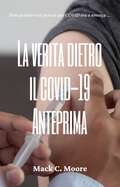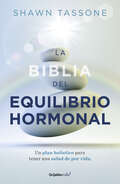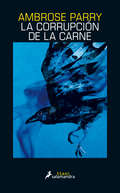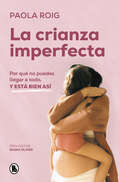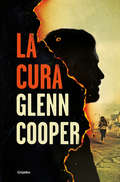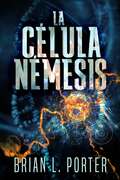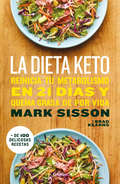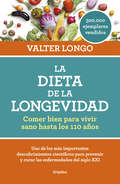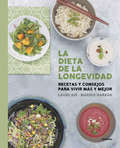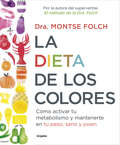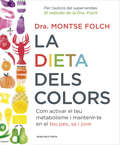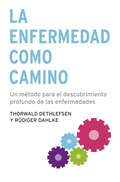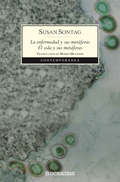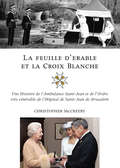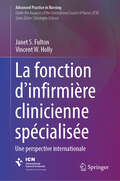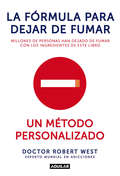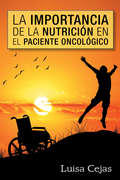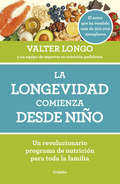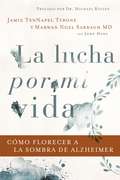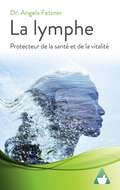- Table View
- List View
La Verità dietro il Covid-19 Anteprima
by Mack C. MooreLa Cina ha approvato la legge sul vaccino prima della pandemia? Esistono report accurati sul Covid-19? I vaccini sono sicuri? È davvero il COVID la reale minaccia? Trova le risposte a queste domande e tanto altro ancora in La Verità dietro il Covid-19 Anteprima. Questo libro analizza i report riguardanti la pandemia e fuga i timori e le preoccupazioni che abbiamo per il COVID. Svela la verità dietro la pandemia di COVID-19. Questa è un'anteprima di una versione più dettagliata ed esplosiva in uscita nel 2021. Scopri le verità che ci stanno nascondendo!
La biblia del equilibrio hormonal: Un plan holístico para tener una salud de por vida
by Tassone Shawn¡Un plan holístico para mantener salud de por vida! ¿Sufres de dolores de cabeza, menstruaciones irregulares o fatiga? No estás sola. Cuatro de cada cinco mujeres enfrentan desequilibrios hormonales que alteran su vida, condiciones debilitantes que causan estragos en su salud física y mental. Por desgracia, la mayoría de estos problemas no se reconocen ni se diagnostican ni se tratan. La biblia del balance hormonal es la culminación de décadas de investigación y trabajo clínico con miles de pacientes del doctor Shawn Tassone, primer médico en los Estados Unidos certificado por la Junta estadounidense de Obstetricia y Ginecología y la Junta estadounidense de Medicina Integrativa. Este libro guiará a las mujeres para que comprendan su perfil hormonal y controlen ese desequilibrio.
La corrupción de la carne
by Ambrose ParryUna trepidante novela criminal que nos sumerge en los experimentos médicos del siglo XIX en Edimburgo. En el invierno de 1847, la muerte campa a sus anchas por las lóbregas calles de Edimburgo, una abigarrada ciudad de médicos, ricos y criminales. Mientras varias jóvenes han sido asesinadas de la forma más salvaje en el casco antiguo, Will Raven está a punto de comenzar su formación con el brillante y reconocido doctor Simpson, a cuya consulta acuden por igual gentes acaudaladas y pobres de esta ciudad fracturada socialmente. En la residencia, dónde se llevan a cabo experimentos con éter y se ensayan nuevas formas de anestesia, Raven conoce a Sarah Fisher, la criada y asistente del eminente doctor, y su carácter e inteligencia desafía y a la vez seduce al joven. Ante la oleada de asesinatos que asola la ciudad y la indiferencia de la policía, Sarah no dudará en unirse a Will y emprender junto a él una investigación que los llevará desde los barrios más siniestros de Edimburgo hasta el núcleo más tenebroso de los problemas científicos de la época. La crítica ha dicho...«Un mundo de sufrimiento. [...] Un Edimburgo victoriano que nos devuelve nítidamente a la vida.»Val McDermid «Un marco histórico fascinante. [...] Un relato de secretos y bisturís, con un pulso narrativo y un gran sentido del humor. [...] Un gran regalo.»The Times «Una trepidante novela criminal que nos sumerge tanto en los experimentos médicos del siglo XIX en Edimburgo como en un período de colorida vida de la ciudad. [...] Un auténtico placer.»Ian Rankin, The Guardian «Personajes y sucesos muy sorprendentes en una novela tan absorbente que no querría que se me acabase nunca.»Denise Mina «Una novedad estimulante. [...] Un marco gótico y un argumento sinuoso basado en aterradores hechos reales.»Nicci French, The Observer «Un debut sorprendente. El oscuro y peligroso pasado cobra vida de forma apasionante. No puedo esperar para leer más sobre Raven y Sarah.»Mark Billingham «Un relato sombrío y elegante, basado en hechos contrastados y en una investigación experta. Un debut enormemente placentero.»Louise Welsh «Excepcional.»Irvine Welsh
La crianza imperfecta: Por qué no puedes llegar a todo, y está bien así
by Paola RoigDespués de Madre, llega un nuevo libro para acompañar en la maternidad y la crianza de la mano de Paola Roig. El libro que necesitamos leer para liberarnos de la culpa y sentirnos acompañadas en el proceso de ser madres. Las madres millenials vivimos en la era de la información. Sabemos qué zapatos son mejores para nuestras criaturas, a qué edad es mejor introducir el gluten en su dieta y también cómo deberíamos acompañarlos en una rabieta.Nos pasamos la crianza intentando cambiar patrones, y hacer las cosas distintas, intentando ser madres de libro. ¿Pero quién habla de todo lo que nos pasa a nosotras mientras intentamos alcanzar todo eso? Cuando me propusieron escribir un segundo libro, decidí que quería que fuese sobre la crianza. No obstante, ya hay tantos libros sobre el tema que es fácil perderse en dar indicaciones y consejos y en vender que todas las soluciones van a poder encontrarse en unas pocas líneas. Yo no quiero participar de eso. Yo quiero hablar de la crianza desde la psicología, claro, pero también desde la vivencia. La de las madres a las que acompaño y la mía propia. Quiero hablar de lo que nos sucede, de todo lo que nos cuesta tanto nombrar, de lo que mueven nuestras criaturas en nosotras y de cómo podemos hacer más sencillo el camino de acompañarlas y de acompañarnos. Esto es lo que encontrarás aquí. Voy a ir recorriendo los aspectos más importantes de la crianza, esos que más nos preocupan y sobre los cuales más leemos. Voy a darte un poco de teoría para entenderlos y ponerlos en contexto, y luego te plantearé preguntas para que tú puedas escoger tu propio camino, confiando en tus recursos y todo aquello que ya tienes dentro de ti. No, este no es otro manual sobre como ser una madre perfecta. Es un libro para encontrar y confiar en la madre suficientemente buena que ya eres.
La cuidadora
by Elaina J. DavidsonUna cuidadora se convierte en la confesora de una paciente infame. Emma Reed es la enfermera a cargo de una unidad de cuidados paliativos. Cuando ingresan a Celeste Harwood, sospecha de los motivos de la mujer. ¿Ha venido Celeste a esconderse del mundo? Si es así, no es justo; su cama debería ir a alguien que la merezca. Cuando Emma ve lo cautelosas que son las enfermeras con la señorita Harwood, comprende que algo está pasando. Su médico llega y cuenta la historia de un asesinato, de una mujer a punto de sufrir una muerte terrible, y a Emma se le despierta la curiosidad. Afortunadamente, Celeste quiere compartir su historia...
La cura
by Glenn CooperUn virus muy contagioso destruye la memoria y lleva la sociedad al borde del colapso. Después de años de investigación, el doctor Steadman está a punto de saborear el éxito y ser aclamado como el creador de la cura del Alzheimer. Poco importa si para llegar hasta ahí ha corrido un enorme riesgo que puede acabar con la humanidad. Su negligencia ha provocado una mutación de la cura en un virus extraordinariamente contagioso que arrasa la memoria de las víctimas y las lleva a un terrible estado de indefensión absoluta. Una catástrofe global. En pocos días, millones de personas en todo el mundo pierden la memoria a causa de un virus desconocido y muy contagioso. Sin recuerdos, hombres y mujeres se comportan como animales, empujados por el hambre y el miedo. Las ciudades están al borde del colapso, sin suministro eléctrico, ni agua corriente, ni alimentos. Solo unos pocos parecen inmunes al contagio y se refugian en sus casas, a la espera de un milagro. Jamie Abbott, un neurocijano que ha participado en la investigación, se embarca en un largo viaje junto a su hija, una de las primeras contagiadas, para colaborar en una cura eficaz que pueda detener la pandemia. El mundo se ha vuelto un lugar inhóspito y muy peligroso, la única esperanza del doctor Abbot es que todavía quede alguien ahí fuera que recuerde qué es lo que nos hace humanos. Porque cuando todas las certezas se desvanecen y la memoria se evapora, es necesario unir las fuerzas y actuar antes de que la civilización se convierta en una tabula rasa. Reseñas:«Cooper no es un escritor de thrillers cualquiera, sino uno que da respuesta a los grandes temas.»Sunday Telegraph «Dinámico y original, Cooper se entrega.»Sun «Estilo excepcional, tensión y un argumento que engancha.»Eurocrime «Con mucho ritmo e inspiracional... no te decepcionará.»Fresh Fiction «Incandescente y explosivo.»James Rollins «Un grandísisimo escritor.»Gianluigi Nuzzi
La célula Némesis
by Brian L. Porter Lic. Cinthya Rivera DíazUn grupo de mujeres se reúne en una clínica belga de fertilidad, donde la Dra. Margherita Dumas ofrece un tratamiento revolucionario y experimental para sus problemas de infertilidad. Un año más tarde, cada una de las mujeres da a luz bebés sanos. Treinta años después, un misterioso asesino comienza a deshacerse de los niños nacidos como resultado del programa de Dumas. El Detective Inspector Harry Houston y su equipo son asignados para reconstruir el caso y llevar al asesino ante la justicia. Con el poco tiempo y pocas pistas disponibles, ¿podrán Harry y su equipo encontrar el vínculo entre los acontecimientos del pasado y las muertes de la progenie inocente de la Clínica Sobel? "La célula Némesis" de Brian L. Porter es una historia escalofriante de explotación científica, asesinato y misterio.
La dieta Keto: Reinicia tu metabolismo en 21 días y quema grasa de forma definitiva
by Mark SissonUn innovador plan en 21 días que te enseñará a restablecer tu metabolismo para que quemes grasa y no la recuperes. Una dieta sana y efectiva. En tan solo 21 días puedes reprogramar tu metabolismo para quemar grasa como combustible, abandonando granos procesados, azúcares y aceites vegetales refinados en favor de alimentos ricos en nutrientes, altos en grasa y primarios / paleo: los resultados son inmediatos. Con más de 100 recetas deliciosas, aprende cómo llevar a cabo el cambio de vida más profundo que conseguirá que pierdas peso y mejores tu salud para que tu cuerpo se transforme. El experto en salud y bienestar Mark Sisson es el autor bestseller Los diez mandamientos del cavernícola y una de las voces más importantes en torno al Movimiento de Salud Evolutiva. Su blog, MarksDailyApple.com, ha permitido que los entusiastas del movimiento paleo desafíen la sabiduría convencional sobre alimentación y ejercicio y asuman un papel activo en torno a su salud y bienestar. Mark Sisson es egresado de la licenciatura en biología por el Williams College y es excampeón de Ironman. La crítica ha dicho...«La creciente popularidad de Keto ha resultado en un exceso de exageraciones y en intentos desacertados de acortar el proceso de adaptación de las grasas. La Keto Reset Diet toma un enfoque reflexivo, paciente y centrado en el estilo de vida para brindarte todos los beneficios de salud sin quemarte.»Melissa Hartwig, autora de best sellers y cofundadora de Whole30 «La estrategia global de Mark Sisson que combina la transformación dietética con el ejercicio, el sueño y las prácticas de control del estrés asegura el éxito y la diversión de quien lo pone en práctica.»Robb Wolf, autor de La solución paleo «La dieta Keto de Mark Sisson abre la puerta a una mejora de la salud ampliando el alcance de su revolucionario enfoque a la salud y la longevidad. Ofrece una guía completa que nos permite introducir los resultados que la investigación de primera línea está validando. Este libro guiará a los lectores a lograr el éxito en lo que se refiere a la mejora de la salud y la pérdida de peso.»Dr. David Perlmutter, autor del best seller Cerebro de pan «Consejos de primera línea de un atleta de talla mundial. Mark Sisson nos presenta una sólida formula de alimentación y estilo de vida cetogénico que cualquier persona de cualquier edad y nivel atlético puede seguir para construir un cuerpo más en forma, más delgado y más saludable. La dieta Keto proporciona el qué, el cómo y, lo mejor de todo, los por qué de la dieta cetogénica. Si has oído hablar de los espectaculares cambios en la salud y el estado físico que pueden producirse con una dieta cetogénica, este es tu libro.»Dr. Michael R. Eades, coautor de Protein Power
La dieta de la longevidad: Comer bien para vivir sano hasta los 110 años
by Valter LongoEn La dieta de la longevidad Valter Longo, el «gurú de la longevidad», recoge uno de los más importantes descubrimientos científicos en el campo de la alimentación: la clave para prevenir y curar las enfermedades más comunes del siglo XXI. Basado en un revolucionario estudio de la dieta de la población más longeva del mundo. Tienes ante ti uno de los descubrimientos científicos más revolucionarios en el campo del envejecimiento: cómo prevenir y curar las enfermedades más comunes del s. XXI a través de la alimentación. Revolucionario porque se ha demostrado que la capacidad de mantenernos jóvenes e incluso la de regenerarnos, está dentro de nosotros, en nuestro cuerpo, y que podemos reprogramar nuestras células y reducir los factores de riesgo de enfermedades como la diabetes, patologías cardiovasculares e autoinmunes, enfermedades neurodegenerativas como el Alzheimer o el cáncer con un régimen alimentario basado en los hábitos de la población más longeva del mundo. Con su dieta casi vegana, de dos o tres comidas al día repartidas entre 12 horas, y varios ayunos al año, además de otros muchos consejos y recetas, podrás mantener o recuperar un cuerpo sano hasta superados los 100 años.
La dieta de la longevidad: Comer bien para vivir sano hasta los 110 años
by Valter LongoEn La dieta de la longevidad Valter Longo, el «gurú de la longevidad», recoge uno de los más importantes descubrimientos científicos en el campo de la alimentación: la clave para prevenir y curar las enfermedades más comunes del siglo XXI. Basado en un revolucionario estudio de la dieta de la población más longeva del mundo. Tienes ante ti uno de los descubrimientos científicos más revolucionarios en el campo del envejecimiento: cómo prevenir y curar las enfermedades más comunes del s. XXI a través de la alimentación. Revolucionario porque se ha demostrado que la capacidad de mantenernos jóvenes e incluso la de regenerarnos, está dentro de nosotros, en nuestro cuerpo, y que podemos reprogramar nuestras células y reducir los factores de riesgo de enfermedades como la diabetes, patologías cardiovasculares e autoinmunes, enfermedades neurodegenerativas como el Alzheimer o el cáncer con un régimen alimentario basado en los hábitos de la población más longeva del mundo. Con su dieta casi vegana, de dos o tres comidas al día repartidas entre 12 horas, y varios ayunos al año, además de otros muchos consejos y recetas, podrás mantener o recuperar un cuerpo sano hasta superados los 100 años.
La dieta de la longevidad: Recetas y consejos para vivir más y mejor
by Dra. Kathy Bonan Laure KiéUn libro ilustrado de recetas, menús y consejos cotidianos basados en el método Okinawa, la dieta para vivir más y mejor. Okinawa es una pequeña isla al sur de Japón cuyos habitantes son los seres humanos más longevos del planeta. Sus ancianos tienen las tasas más bajas del mundo en enfermedades ligadas al envejecimiento, como la hipertensión arterial, la osteoporosis, la diabetes o el cáncer. ¿Cuál es su secreto? El método Okinawa propone una dieta sana y equilibrada, baja en calorías y rica en nutrientes protectores que, combinada con un actividad física regular, un entorno bajo en estrés, una vida espiritual rica y un vínculo social fuerte, puede aumentar nuestra esperanza de vida. Los menús y recetas de este libro, basados en la tradición japonesa, permiten poner en práctica el método Okinawa con productos que podemos encontrar en nuestro país. Además integran matices de la gastronomía francesa, que aportan originalidad y creatividad a cada uno de los platos.
La dieta de los colores
by Montse FolchUna dieta sencilla, clara, efectiva y basada en la dieta mediterránea que te ayudará a perder peso mientras incorporas nuevos hábitos alimentarios saludables y luchas contra el envejecimiento. Salud, belleza, comodidad, sentirnos mejor con nuestro cuerpo, rejuvenecidos y más ágiles. Estos son los principales objetivos que nos fijamos cuando empezamos una dieta y, aunque son razones suficientes para comer de forma saludable durante el resto de nuestra vida, muchas veces acabamos arrinconándolas y recuperando las viejas costumbres. La mayoría de nosotros estamos sometidos a un ritmo de vida que nos dificulta prestar la atención necesaria a nuestro organismo y mimarlo para conseguir la mejor recompensa: el bienestar físico y psicológico. A los obstáculos cotidianos (poco tiempo para hacer la compra y cocinar, comer fuera de casa, comidas de compromiso, etc.), se suman unas dietas que, a menudo, exigen un alto nivel de sacrificio y son tan restrictivas que nos empujan a abandonar pronto. Por eso la dieta de los colores es sencilla y variada, porque una de sus máximas es hacer siempre de la comida un acto placentero y no convertirlo en algo penoso, lo que aumentaría mucho nuestras posibilidades de fracaso. El menú de nuestra dieta se divide en cuatro colores: rojo para las proteínas, vegetales y animales; verde para los vegetales; amarillo para el azúcar y los hidratos de carbono; y marrón para las grasas. Además, en el azul incluiremos los líquidos y los condimentos. Las mujeres seguirán la pauta 3 + 3 + 3 (tres alimentos del grupo rojo, tres del amarillo y tres del marrón) y los hombres la de 4 + 4 + 4 (cuatro de cada grupo). Y ahora la buena noticia: el grupo verde es de consumo libre en cantidades y raciones para ambos sexos. ¿A qué esperas para empezar la dieta de los colores y sentirte mejor, estar más delgado y retrasar tu envejecimiento?
La dieta dels colors: Com activar el teu metabolisme i mantenir-te en el teu pes, sa i jove
by Montse FolchUna dieta senzilla, clara, efectiva i basada en la dieta mediterrània que t'ajudarà a perdre pes al tems que incorpores nous hàbits alimentaris saludables i lluites contra l'envelliment. Salut, bellesa, comoditat, sentir-nos millor amb el nostre cos, rejovenits i més àgils. Aquests són els principals objectius que ens fixem quan comencem una dieta i, tot i que són raons suficients per menjar de forma saludable durant la resta de les nostres vides, la realitat és que en general arraconem i recuperem els vells costums. La majoria de nosaltres estem sotmesos a un ritme de vida que ens fa difícil parar l'atenció necessària al nostre organisme i mimar-lo per aconseguir el benestar físic i psicològic. Als obstacles quotidians (poc temps per comprar i cuinar, àpats fora de casa, de compromís, etc.), s'hi afegeixen dietes que, sovint, exigeixen un alt nivell de sacrifici i són tan restrictives que ens fan abandonar benràpid. Per això la dieta dels colors és senzilla i variada, perquè una de les màximes és fer sempre del menjar un acte plaent i no convertir-lo en quelcom penós, cosa que augmentaria considerablement les nostres possibilitats de fallida. El menú de la nostra dieta es divideix en quatre colors: vermell per a les proteïnes, vegetals i animals; verd per als vegetals; groc per al sucre i els hidrats de carboni i marró per als greixos. A banda, en el blau inclourem els líquids i condiments. Les dones seguiran la pauta 3+3+3 (tres aliments del grup vermell, tres del groc i tres del marró) i els homes la 4+4+4 (quatre aliments de cada grup). I ara la bona notícia: el grup verd és de consum lliure en quantitats i racions per als dos sexes. A què esperes per començar la dieta dels colors i sentir-te millor, perdre els quilos que et sobren i endarrerir l'envelliment?
La energia sanadora de la enfermedad
by Clara Estrada CanoEl inspirador testimonio de la reconocida periodista Clara Estrada de cómo supero la enfermedad. Clara Estrada tuvo que enfrentarse a dos diagnósticos graves en poco tiempo: un condrosarcoma —un agresivo cáncer que ataca la pelvis— y, dos años después, lupus, una afección autoinmune. En este inspirador testimonio, la autora nos cuenta cómo hizo para salir adelante después de sentir que la enfermedad le arrebataba la vida, que las cirugías y las recuperaciones parecían infinitas y el dolor insoportable. Esta es la historia de una mujer valiente que, gracias a sus dolencias, encontró diferentes herramientas, como el amor propio, la psicoterapia y la espiritualidad, para sanar su cuerpo y su alma y sacar lo mejor de sí misma.
La enfermedad como camino: Un método para el descubrimiento profundo de las enfermedades
by Thorwald DethlefsenLa enfermedad como camino analiza el significado de los quebrantos de salud más habituales. No hay una diversidad de enfermedades curables, sino una sola enfermedad determinante del «mal estar» del individuo. Lo que llamamos enfermedades son en realidad síntomas de esta única enfermedad.Este libro analiza el significado de las infecciones, los dolores de cabeza, los trastornos cardíacos y los quebrantos de salud más habituales. Todos los síntomas tienen un sentido profundo para la vida de la persona: nos transmiten mensajes del ámbito espiritual, y de su adecuada interpretación dependerá nuestra capacidad de recuperarnos. Se incluye un capítulo especial dedicado al problema del sida, así como un índice de enfermedades y una relación de las partes y los órganos del cuerpo con sus atributos psíquicos.
La enfermedad y sus metáforas | El sida y sus metáforas
by Susan SontagEste volumen reúne los ensayos, La enfermedad y sus metáforas y El sida y sus metáforas, que siguen ejerciendo una influencia enorme en la reflexión médica y en las vidas de miles de pacientes y cuidadores. Susan Sontag escribió La enfermedad y sus metáforas en 1978, mientras se trataba de un cáncer. En el libro quiso demostrar cómo los mitos acerca de algunas enfermedades, en especial del cáncer, añaden más dolor al sufrimiento de los pacientes y a menudo los cohíben en la búsqueda de tratamiento adecuado. Casi una década después, con la irrupción de una nueva enfermedad estigmatizada y transida de incertidumbres y «fantasías punitivas», Sontag escribió El sida y sus metáforas, extendiendo los argumentos del libro anterior a la pandemia de sida. Reseña:«Un ensayo luminoso.»Cristina Peri Rossi
La enfermedad, el sufrimiento y la muerte
by Fernando Bermúdez LópezEste trabajo gira en torno a tres grandes cuestiones que angustian a la humanidad: la enfermedad, el sufrimiento y la muerte. La medicina ha avanzado notablemente en los últimos años. Ha habido nuevos descubrimientos en el campo de la prevención, del diagnóstico y del tratamiento de enfermedades que, sin embargo, no han podido ni podrán lograr acabar con la carga de sufrimiento que conllevan la enfermedad y la muerte.
La feuille d'erable et la Croix-Blanche
by Christopher MccreeryEn tant que fondation de l’Ordre de Saint-Jean, Ambulance Saint-Jean assure la prestation de cours de secourisme au Canada depuis maintenant 125 ans. De l’aide apportée sur les chantiers ferroviaires de la Belle Époque et dans les hôpitaux militaires de la Première Guerre mondiale aux programmes et services offerts par l’organisme bénévole que nous connaissons aujourd’hui, le présent ouvrage décrit les inestimables contributions de l’Ordre à notre pays et retrace la remarquable histoire de tous ceux qui ont permis à l’Ordre d’exister. Perpétuant une ancienne tradition hospitalière qui remonte aux dixième et onzième siècles, l’Ordre de Saint-Jean moderne prit racine dans la reprise des activités de bienfaisance en Angleterre en 1831. En 1883, la constitution de l’Ordre de Saint-Jean au Canada marqua le début d’une longue et distinguée histoire de services rendus aux Canadiens et aux populations du monde entier. Organisme bénévole national regroupant plus de 25 000 Canadiens, Ambulance Saint-Jean demeure à ce jour le chef de file canadien en matière de formation en secourisme.
La fonction d’infirmière clinicienne spécialisée: Une perspective internationale (Advanced Practice in Nursing)
by Janet S. Fulton Vincent W. HollyRédigé sous la direction du Conseil international des infirmières (CII), ce livre fait partie d&’une collection qui explore la pratique avancée infirmière au niveau international. Il s&’agit du premier ouvrage à offrir une vision globale de la pratique avancée del&’infirmière clinicienne spécialisée (ICS) ou Clinical Nurse Specialist (CNS) en anglais. En effet, il explore de manière approfondie cette fonction en abordant les modèles de pratique, les compétences de base, les recommandations relatives aux programmes deformation, les résultats cliniques évalués ainsi que les exigences réglementaires relatives au champ d&’intervention des ICS.L&’exercice de l&’infirmière clinicienne spécialisée tel qu&’il est mis en oeuvre en Amérique du Nord, en Europe, en Asie et en Océanie, est analysé en le replaçant dans le contexte du système de santé du pays, de l&’appareil de formation et des exigences législatives etréglementaires. Des exemples décrivent la mise en oeuvre de la fonction dans différents domaines spécialisés dans le but de faire progresser les soins infirmiers et d&’améliorer les résultats cliniques. L&’évaluation des résultats imputables à la pratique de l&’ICS dans les différents contextes de pays et de systèmes de soins de santé est également examinée. Ce livre apporte une étude approfondie de la fonction d&’ICS dans une approche systémique et mondialisée. Les responsables d&’encadrement pourront acquérir grâce à cet ouvrage une compréhension des fondements de la fonction d&’ICS et des attentes en matière d&’exercice et de performance. Les enseignants utiliseront ce livre comme une ressource pour le développement des programmes de formation, tandis que les étudiantsbénéficieront d'une vision globale de l&’exercice de l&’ICS. Les différentes fonctions regroupées sous l&’appellation de pratique avancée, y compris celle de l&’ICS, continuent d&’évoluer. Ce livre permettra de mieux appréhender la contribution essentielle apportée par l&’infirmière clinicienne spécialisée. Ce livre a été traduit de l&’anglais. La traduction a été réalisée à l&’aide d&’une intelligence artificielle. Une révision par un expert du domaine a ensuite été effectuée, principalement en termes de contenu.
La fórmula para dejar de fumar: Un metodo personalizado
by Robert WestDescubre cómo puedes dejar de fumar a tu ritmo.Millones de personas han dejado de fumar con los ingredientes de este libro.¿Has intentado dejar de fumar con anterioridad? Si al final volviste a encender otro cigarrillo habrás pensado que fracasaste, pero es justamente lo contrario: vas por el buen camino. A diferencia de lo que solemos pensar, normalmente los fumadores recaen varias veces antes de dejar de fumar definitivamente.Este libro no es una receta mágica. La fórmula para dejar de fumar no pretende hacerte creer que hay un único camino para olvidarse del tabaco, ya que cualquier fumador sabe que a la hora de dejarlo influyen distintos factores dependiendo de la persona y del momento en el que se haga. Este libro te mostrará todos los materiales que tenemos a nuestro alcance para que puedas encontrar TU método, el mejor método personalizado para dejar de fumar.El doctor Robert West lleva investigando instrumentos, terapias y medicamentos para dejar de fumar desde hace más de treinta años y ahora nos guía a través del laberinto de todas las opciones disponibles para así revelarnos cuáles son las más eficaces y cómo se pueden combinar estos «ingredientes» para que el propio fumador establezca la receta que mejor se ajuste a su caso.Este libro da respuesta a preguntas tan comunes como:¿Debería reducir gradualmente el consumo de cigarrillos o dejarlo de golpe? ¿Debería usar parches de nicotina?¿Son los cigarrillos electrónicos efi caces?¿Cuál es la mejor manera de combatir el deseo de fumar?¿Cómo puedo evitar el aumento de peso cuando deje de fumar?
La historia de Cassie
by Brian L. PorterEsta es la historia de Cassie: una perrita de rescate que tenía poco más de dos años cuando se unió a la familia de rescates de Brian y Juliet, habiendo tenido ya tres dueños anteriores en su corta vida. La pequeña terrier pronto se abrió camino en los corazones de la familia, y sus payasadas y su actitud sobredimensionada le valieron rápidamente los apodos de'El hurón loco' y'La bruja malvada del Oeste'. Cassie puede describirse mejor como una 'dinamo de bolsillo' o, como dice el autor, "está llena de energía ilimitada y, a pesar de tener catorce años, es como un conejito de Duracell sin interruptor de apagado". Cassie se ha recuperado de las operaciones, se las arregló para perderse y fue encontrada en una tarde, ahuyentó a los Rottweilers y Dobermans que han tenido el valor de intentar robar su pelota de tenis, y se encontró a sí misma lesionada por interferir en las peleas de perros más grandes. La gente no puede evitar enamorarse de este pequeño bulto de alegría.
La importancia de la nutrición en el paciente oncológico
by Luisa CejasLa incapacidad para mantener un adecuado estado nutricional es un problema frecuente en el paciente oncológico. La propia enfermedad, así como las diferentes variedades de tratamiento onco específicos, puede conducir a la desnutrición energético-nutrimental, que puede ser grave, con implicaciones pronósticas, debido a la escasa tolerancia y respuesta a la terapéutica cito reductora. El apoyo nutricional en el paciente con cáncer continúa siendo unos de los mayores problemas por resolver. Sin embargo, nos consta que actualmente hay una mejor apreciación de la necesidad de la evaluación nutricional temprana, así como el apoyo nutricional, con los principales objetivos de mejorar la respuesta al tratamiento oncológico, disminuir las complicaciones que puedan originar la misma enfermedad, y permitirle al enfermo una mejor calidad de vida.
La longevidad comienza desde niño: Un revolucionario programa de nutrición para toda la familia
by Valter LongoValter Longo presenta La longevidad comienza desde niño, la continuación de su gran éxito, La dieta de la longevidad, en el que encontrarás el primer programa de alimentación para mejorar la salud de la toda la familia ya desde el embarazo. ¿A qué edad empieza la longevidad? Valter Longo responde a esta pregunta con su nuevo libro, La longevidad comienza desde niño, en el que presenta un plan de nutrición y salud para una vida larga y saludable, que comienza desde el embarazo y con el que todos los miembros de la familia viviremos sanos hasta los 110 años. Con la colaboración de expertos en pediatría y nutrición, el libro ofrece un análisis sobre la alimentación infantil y juvenil para prevenir (o revertir) el sobrepeso y la progresión de enfermedades causadas por los malos hábitos alimenticios. Además, responde a las dudas más comunes de las madres y padres actuales: la alimentación durante el embarazo, las dietas vegetarianas en la adolescencia, las cantidades y los alimentos adecuados para un bebé en la fase de destete y mucho más.
La lucha por mi vida: Cómo florecer a la sombra de Alzheimer
by Jamie TenNapel Tyrone Marwan Noel Sabbagh MD, FAANJamie Tyrone tenía cuarenta y nueve años cuando se enteró de que poseía una predisposición genética al Mal de Alzheimer. De hecho, sus genes arrojaron un 91% de probabilidad de contraer la enfermedad durante el trascurso de su vida. Sorprendida por la forma en que recibió el diagnóstico a través de pruebas genéticas, y dolorosamente familiarizada con el padecimiento debido a su historia familiar y su experiencia como enfermera, sintió como si portara una bomba de tiempo dentro de su cuerpo, lista para explotar de un momento a otro.Luego de luchar con una depresión inicial, decidió ponerse en acción en vez de ceder a una actitud de derrota. Comenzó fundando B.A.B.E.S. [Vencer el Alzheimer Abrazando la Ciencia, por sus siglas en inglés] para recaudar dinero y fomentar la conciencia de la necesidad de encontrar una curación. Motivada por ese equipo, Jamie se asoció con el renombrado neurólogo Dr. Marwan Sabbagh para escribir Defusing the Alzheimer's Time Bomb [Desactivando la bomba de tiempo del Alzheimer], una guía práctica y útil para los que saben que tienen un alto riesgo de contraer el Mal de Alzheimer.Este libro es sinigual porque brinda consejos médicos experimentados por parte del Dr. Sabbagh junto con las historias reales de Jamie, una mujer que vive bajo la amenaza del Alzheimer. Además, Defusing the Alzheimer's Time Bomb es uno de los únicos libros en el mercado que analiza de manera franca los pros, los contras y los posibles peligros de las pruebas genéticas.
La lymphe: Protecteur de la santé et de la vitalité
by Dr Angela FetznerLe nettoyage lymphatique : le parent pauvre de toutes les cures de détoxication Sur plus de 250 pages, vous trouverez des informations complètes sur la lymphe, dont les fonctions sont plutôt inconnues par rapport à celles du sang, par exemple. Alors que le nettoyage intestinal ou la détoxication du foie sont en tête du programme de toute thérapie de détoxication, la détoxication du système lymphatique est généralement traitée de manière trop négligeable. Toutefois, une détoxication régulière du système lymphatique est d'une importance capitale, car un système lymphatique fonctionnel est indispensable à la santé physique et psychique. Le système lymphatique, épurateur de notre organisme Le système lymphatique détruit les substances nocives et inutilisables telles que les agents pathogènes, les déchets métaboliques, les toxines et les débris cellulaires. Le système lymphatique est donc une part extrêmement importante de la défense immunitaire et de la détoxication de l'organisme. La lymphe, source de vie, cause de décès La lymphe doit rester dans le fluxLe système lymphatique doit être nettoyé et détoxifié régulièrement pour rester dans son flux naturel. Cependant, si le système lymphatique est continuellement surchargé par trop de déchets, le flux s'arrête. La lymphe s'écoule très lentement et longuement, jusqu'à ce qu'un œdème lymphatique se développe. Par conséquent, toutes les substances problématiques ne peuvent pas être détruites et l'organisme entier est lentement empoisonné. De nombreuses maladies chroniques peuvent alors se développer. Le purificateur lymphatique holistique Ce livre décrit toutes les thérapies naturelles et les méthodes de traitement qui se sont avérées efficaces pour une détoxication essentielle et le nettoyage de la lymphe. Il s’agit des mesures quotidiennes, motivantes et efficaces d'auto-traitement. Cela inclut toutes les mesures de détoxica
